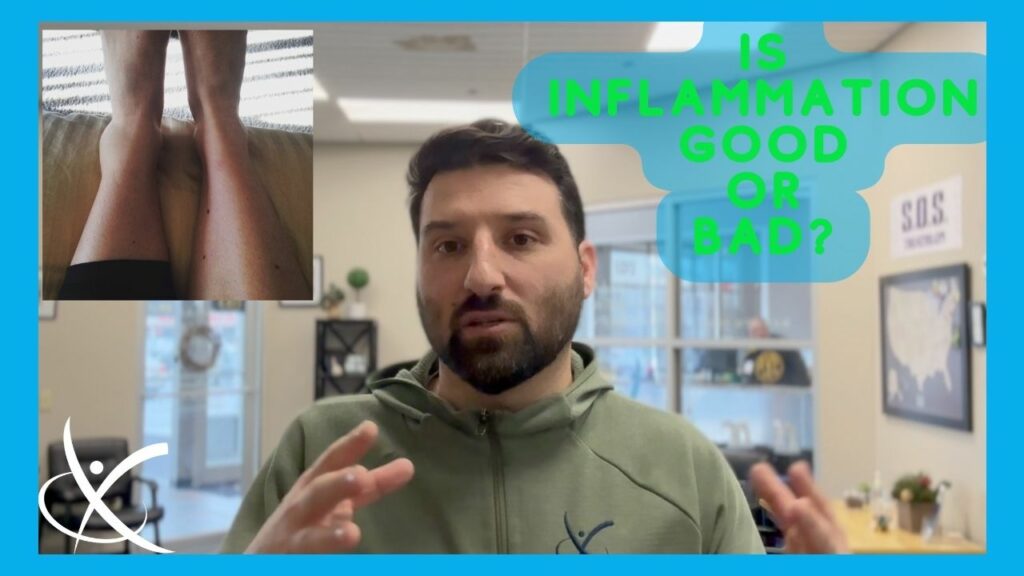Is Inflammation Good Or Bad?
Inflammation gets a bad rap. It’s essentially the boogeyman for any active individual or anyone who wants to continue to move throughout their day. Inflammation = bad and that’s the end. Fortunately, there’s more to the story. Let’s discuss what inflammation is, whether it’s good or bad, where it can happen, how we know if we have it, and how long it will last.
What is inflammation?
For this blog we’ll discuss inflammation as it relates to the musculoskeletal system. Simply put, inflammation is actually a normal response to a physical irritation within the body. In fact, it is a necessary and beneficial immune response to kickstart healing in an injured area. Read that again, it is a necessary and beneficial process after an injury. Do I have your attention yet? Good!
What Can Get Inflamed?
Injuries to tendons, muscles, ligaments, and bones requires that the body respond to damaged tissue with an immediate inflammatory response. I’m not talking about any random pain in those areas. Not all pain is a physical damage to tissue. Previously I wrote a blog discussing the different stages of tendon injury or presentation (INSERT BLOG LINK HERE) which is a beneficial read if you’re unfamiliar. Not all injuries have associated inflammation. But some injuries absolutely do. When this happens damaged cells release chemicals that signal your body to release hormones to help heal. These chemicals and hormones cause blood vessels to dilate in order to get more blood (the healing juice) to the area. These chemicals, immune cells, and hormones are also noxious to the nerves so they become irritated and we experience a localized pain response. You might think this is bad, however this is a protective mechanism that causes us to limit use of the injured area to allow proper healing. In fact, prolonged inflammatory responses are usually a result of inadequate protection and rest of an newly acquired injury.
What Are the Signs of Inflammation?
Typically there are five clinical signs of localized musculoskeletal inflammation:
- Redness
- Swelling
- Warmth
- Pain
- Weakness/Loss of Function
The increased blood flow to the area of concern causes redness, swelling, and warmth. The blood vessels are dilated by the chemicals and some may even be physically damaged by the injury itself. This causes a significant increase in fluid volume at the site which will result in swelling (think of adding water to a water balloon), warmth, and redness.
The pain, as we have already discussed, is a combination of damaged nerve endings from the injury and also resting pain can be explained by the chemical irritation to the local nerves. With true inflammation or even a “tendinitis” there will be a classic resting pain response which is often (not always) different from a non-inflammatory tendon injury. But in the case of acute injury and inflammation, resting pain will exist and this will become exacerbated with movement.
Finally a loss of function or loss of strength exists because physical tissue is compromised and the pain will also decrease efficiency of the structures involved and limit function.
If you are experiencing a combination or all of these symptoms there is a good chance you have an acute injury with resultant inflammation.
How long does this last?
What do we mean by acute? Another important distinction after injury is the phase(s) of healing. The first four days are considered the acute phase marked by a sudden increase in pain, swelling (bleeding) and often immobility. The body is attempting damage control with the swelling and taking care of the first necessary steps in the process.
The next two weeks are what we call the sub-acute phase where the body is creating new tissue that requires attention in order to strengthen and become healthy strong tissue.
First week: Bleeding & Inflammation
Second Week+ : Proliferation & Remodeling
During the proliferative phase the body is physically laying down new tendon tissue, muscle tissue, ligament tissue, or bone. Think of it like adding new spackle to patch the holes in your wall. It goes on wet and sloppy and must be smoothed out, given time to dry/harden, and then must be sanded. That is the remodeling phase. After the body lays down the new immature tissue it is up to us to ensure proper remodeling through a comprehensive rehab plan.
This is also why we discourage individuals from returning to activity too quickly after significant injury. The full repair is not complete and the area is still at high risk for re-injury. Pain levels will drop significantly after the acute phase but that is not indicative of adequate healing. It is far better to see the full process through rather than compromise healing and risk further injury because that will only prolong the process in the long run.
I hope this provides some perspective on the crazy thing we all try to avoid like the plague. Injuries are certainly not enjoyable by any means but we should remember the body is an amazing piece of equipment. If you understand the process then you can trust the process and have far better outcomes. At the very least we can help you manage your expectations and appreciate our advice when it comes to rehab and ultimately a return to activity.
Happy Training!
